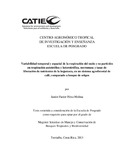Variabilidad temporal y espacial de la respiración del suelo y su partición en respiración autotrófica y heterotrófica, necromasa y tasas de liberación de nutrientes de la hojarasca, en un sistema agroforestal de café, comparado a bosque de origen
Date
2013Author
Pérez Molina, Junior Pastor
Autor Corporativo
CATIE - Centro Agronómico Tropical de Investigación y Enseñanza
Type
Tesis de maestría
Metadata
Show full item recordDescription
Tesis (Mag.Sc.) -- CATIE, 2013 82 páginas : 27 ilustraciones, 2 tablas ; 21.59 x 27.94 cm. Incluye bibliografía en las páginas 79-80
Abstract
Los sistemas agroforestales de café (SAC) están entre las prácticas más extendidas en las zonas tropicales para recuperar áreas degradadas y deforestadas, cuyo interés particular es equilibrar el presupuesto de carbono global. Esta investigación fue desarrollada en un SAC y tuvo como objetivos: (i) medir la variabilidad temporal y espacial de la respiración del suelo (Rs) de un SAC durante un período de cuatro años; (ii) establecer las relaciones de la precipitación, temperatura, humedad, respiración del ecosistema (Reco) y productividad primaria neta (GPP) sobre la Rs y construir un modelo empirico para predecir Rs; (iii) separar la Rs entre respiración autotrófica (Ra) y heterotrófica (Rh); (iv) comparar la Rs entre un SAC y un bosque secundario (BS), (v) comparar la composición de la necromasa sobre el suelo y concentraciones de nutrientes entre un SAC y un bosque secundario de origen y (vi) evaluar las tasas de descomposición (k) y liberación de nutrientes de la hojarasca de C. y poró según sus estados (fresco o viejo), sus mezcla (pura o mezclada entre café y poro) y su lugar de descomposicion (bajo sombra de poró y pleno sol). Los resultados de este estudio indican, en cierta medida, que el contraste en la Rs entre el BS y el SAC, se debe a diferencias entre la productividad subterránea. Ecosystem respiration is a major C flux in terrestrial ecosysteMON, potentially canceling out photosynthesis. We evaluated the role of Rs in a coffee agroforestry system (CAF); CAF are agro-ecosysteMON that are commonly found in the tropics and of particular interest because they have the potential to be net carbon sinks. Our objectives were (i) to assess the long-term temporal and spatial variability of Rs, (ii) to establish the relationship between Rs, precipitation, temperature, soil moisture, ecosystem respiration (Reco), and gross primary productivity (GPP), (iii) to partition Rs into its autotrophic (Ra) and heterotrophic (Rh) components, and (iv) to compare Rs between CAF and secondary forest of origin (SF), (v) compare the composition of the necromass and nutrient concentrations between SAC and BS, (vi) assess decomposition rates (k) and release of nutrients from the leaves of C. arabica (coffee, fresh leaves: CF and old leaves: CV ) and poró (old leaves: PV) spatial level (low poró shade and full sun), and the interactions between the types of litter. The results of this study indicate, to some extent, that the contrast in the Rs between the SF and CAF, is due to differences between the ground productivity.
Keywords
Asesor
Van den Meersche, Karel
Siles, Pablo
Publisher
CATIE, Turrialba (Costa Rica)
URI (Permanet link to cite or share this item)
https://repositorio.catie.ac.cr/handle/11554/4302Collections
- Tesis [1392]


